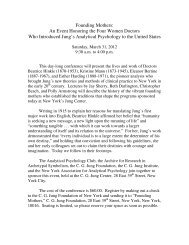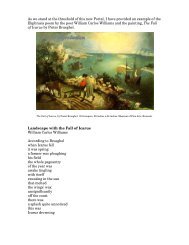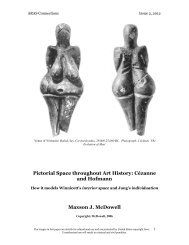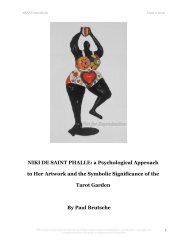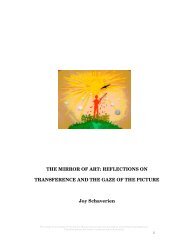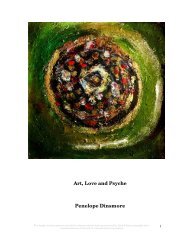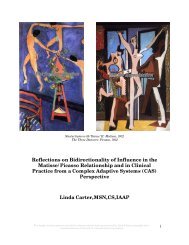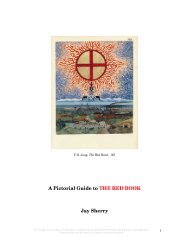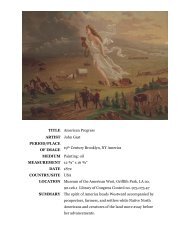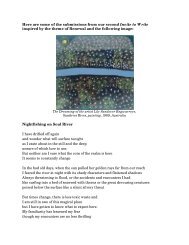The Mandala in Tibetan Buddhism by Martin Brauen - ARAS
The Mandala in Tibetan Buddhism by Martin Brauen - ARAS
The Mandala in Tibetan Buddhism by Martin Brauen - ARAS
Create successful ePaper yourself
Turn your PDF publications into a flip-book with our unique Google optimized e-Paper software.
<strong>Mandala</strong> of Sarvavid Buddha Vairocana. Tibet; 17 th century.<br />
Ground m<strong>in</strong>eral pigments on cotton. Rub<strong>in</strong> Museum of Art.<br />
<strong>The</strong> <strong>Mandala</strong> <strong>in</strong> <strong>Tibetan</strong> <strong>Buddhism</strong><br />
<strong>by</strong> Mart<strong>in</strong> <strong>Brauen</strong><br />
<strong>The</strong> images <strong>in</strong> this paper are strictly for educational use and are protected <strong>by</strong> United States copyright laws. Unauthorized<br />
use will result <strong>in</strong> crim<strong>in</strong>al and civil penalties.<br />
1
<strong>The</strong> mandala is fundamentally someth<strong>in</strong>g secret. If you are <strong>in</strong>terested <strong>in</strong> it <strong>in</strong><br />
order to acquire reputation, and feel pride <strong>in</strong> show<strong>in</strong>g what you have worked<br />
out to others, you do not have the right attitude. If however your work spr<strong>in</strong>gs<br />
from efforts to offer help to other people, that is the right attitude of m<strong>in</strong>d, which<br />
will contribute to the liberation of yourself and others.<br />
Khenpo Thubten to the author<br />
This article offers an <strong>in</strong>troduction to the mandala as used <strong>by</strong> <strong>Tibetan</strong><br />
Buddhists, and gives a critical perspective on the em<strong>in</strong>ent psychologist C.G.<br />
Jung’s <strong>in</strong>terpretation of the sacred icon. Both are the topics of exhibitions shown<br />
at the Rub<strong>in</strong> Museum of Art (RMA): <strong>Mandala</strong>: <strong>The</strong> Perfect Circle (August 14,<br />
2009 – January 11, 2010) and <strong>The</strong> Red Book of C.G. Jung: Creation of a New<br />
Cosmology (October 7, 2009 – January 25, 2010).<br />
RMA holds one of the world’s most important collections of Himalayan<br />
art. Pa<strong>in</strong>t<strong>in</strong>gs, pictorial textiles, and sculpture are drawn from cultures that<br />
touch upon the arc of mounta<strong>in</strong>s that extends from Afghanistan <strong>in</strong> the northwest<br />
to Myanmar (Burma) <strong>in</strong> the southeast and <strong>in</strong>cludes Tibet, Nepal, Mongolia, and<br />
Bhutan. <strong>The</strong> larger Himalayan cultural sphere, determ<strong>in</strong>ed <strong>by</strong> significant cultural<br />
exchange over millennia, <strong>in</strong>cludes Iran, India, Ch<strong>in</strong>a, Central Asia, and Southeast<br />
Asia. This rich cultural legacy, largely unfamiliar to Western viewers, offers<br />
an uncommon opportunity for visual adventure and aesthetic discovery.<br />
<strong>Tibetan</strong> <strong>Buddhism</strong> relies on the visual with an <strong>in</strong>tensity that far exceeds<br />
other forms of the religion. Understand<strong>in</strong>g the absolute nature of reality to be<br />
devoid of all characteristics and yet fully manifest <strong>in</strong> everyone and everyth<strong>in</strong>g,<br />
<strong>The</strong> images <strong>in</strong> this paper are strictly for educational use and are protected <strong>by</strong> United States copyright laws. Unauthorized<br />
use will result <strong>in</strong> crim<strong>in</strong>al and civil penalties.<br />
2
<strong>Tibetan</strong> Buddhist practitioners engage <strong>in</strong> special practices <strong>in</strong> order to realize the<br />
pure <strong>in</strong> what was previously viewed as impure, realiz<strong>in</strong>g buddhas where before<br />
they knew only of ord<strong>in</strong>ary be<strong>in</strong>gs. Vastly complex pictorial representations of the<br />
Buddhist conception of the world and its deities serve as aids to the meditator.<br />
Figures of deities – be they pa<strong>in</strong>ted on walls or cloth or fashioned out of metal,<br />
wood, or clay – are endowed through consecration to stand <strong>in</strong> for the deities they<br />
represent, enabl<strong>in</strong>g the practitioner to properly visualize the reality he or she<br />
strives to embody.<br />
<strong>The</strong> concept of the mandala is extremely complex, and it is hard to do<br />
justice to the word with only a brief def<strong>in</strong>ition. In dictionaries mandalas are<br />
described variously as magic circles, round ritual geometric or symbolic<br />
diagrams, or, typically, circles that surround a square with a central symbol.<br />
Alternatively, mandalas are expla<strong>in</strong>ed as symbols of the cosmic elements, as<br />
models for certa<strong>in</strong> visualizations, as aids to self-discovery, or as aids to<br />
meditation on the transcendental. All these def<strong>in</strong>itions are correct as far as they<br />
go but are not nearly precise enough.<br />
As a rule a mandala (dkyil-’khor) is a strongly symmetrical diagram<br />
concentrated about a center; it is built up of concentric circles (’khor) and, <strong>in</strong><br />
most cases, squares possess<strong>in</strong>g the same center (dkyil). Almost all mandalas<br />
familiar today display one or more concentric circles <strong>in</strong> the center. <strong>The</strong> basic<br />
construction varies only slightly. About a round, central disk, <strong>in</strong> the middle of<br />
which there sits or stands a deity, four, eight, or ten deities are set <strong>in</strong> an<br />
additional circle. <strong>The</strong>se figures are the assembly or entourage of the most<br />
important deity of the mandala.<br />
Among the plethora of mandala representations, there are a number <strong>in</strong><br />
which the deities are only h<strong>in</strong>ted at, for <strong>in</strong>stance <strong>by</strong> their symbols, <strong>by</strong> their seed<br />
<strong>The</strong> images <strong>in</strong> this paper are strictly for educational use and are protected <strong>by</strong> United States copyright laws. Unauthorized<br />
use will result <strong>in</strong> crim<strong>in</strong>al and civil penalties.<br />
3
syllables, or <strong>by</strong> dots or small circles. Some mandalas may be completely empty,<br />
and these naturally demand greater powers of imag<strong>in</strong>ation. Two-dimensional<br />
mandalas are either pa<strong>in</strong>ted on a cloth ground or on a flat surface <strong>by</strong> spr<strong>in</strong>kl<strong>in</strong>g<br />
colored powders. Whereas the latter types are dismantled at the end of the<br />
relevant mandala ritual, pa<strong>in</strong>ted mandalas can be stored away for future use.<br />
<strong>The</strong> palace and its central area<br />
In the great majority of mandalas known to us, the <strong>in</strong>nermost sacral area<br />
is surrounded <strong>by</strong> a square. Each of the four outer sides of the square is<br />
<strong>in</strong>terrupted <strong>in</strong> the middle <strong>by</strong> a T-shape. <strong>The</strong>se represent entrance gates, s<strong>in</strong>ce the<br />
square <strong>in</strong> the mandala is none other than a build<strong>in</strong>g or the ground plan of a<br />
palace.<br />
Amoghapasa Five-deity <strong>Mandala</strong>. Nepal; 16 th<br />
century. Pigments on cloth. Rub<strong>in</strong> Museum of<br />
Art.<br />
<strong>The</strong> images <strong>in</strong> this paper are strictly for educational use and are protected <strong>by</strong> United States copyright laws. Unauthorized<br />
use will result <strong>in</strong> crim<strong>in</strong>al and civil penalties.<br />
4
Generally the walls of the palace are adorned with str<strong>in</strong>gs of pearls and the<br />
roofs with umbrellas, banners, vases, pennants or other objects. However, <strong>in</strong> a<br />
few mandalas entrails hang on the walls. <strong>The</strong>se are mandalas of certa<strong>in</strong> wrathful<br />
deities, whose palace roofs are sometimes adorned with swords, yaktail fans, and<br />
impaled corpses — <strong>in</strong> place of umbrellas, banners, and so on. An example of such<br />
a mandala is that of Black-cloaked Mahākāla.<br />
As a rule, the square palace area rests on a crossed vajra (viśvavajra),<br />
which forms the adamant<strong>in</strong>e foundation of the mandala palace. <strong>The</strong> four po<strong>in</strong>ts<br />
match the colors of the correspond<strong>in</strong>g card<strong>in</strong>al directions. <strong>The</strong> crossed vajra is<br />
particularly visible <strong>in</strong> three-dimensional mandalas.<br />
<strong>The</strong> conclud<strong>in</strong>g protective circles<br />
In <strong>Tibetan</strong> mandalas familiar to us today, the square palace is<br />
encompassed <strong>by</strong> three or four circles. <strong>The</strong>re is reason to assume that <strong>in</strong> very early<br />
mandalas outer circles were absent, and there were only concentric circles <strong>in</strong>side<br />
a square doma<strong>in</strong>. Outer circles were probably not added until the eleventh or<br />
twelfth century.<br />
<strong>The</strong> three circles or r<strong>in</strong>gs that usually complete a mandala on the outside<br />
are, from the <strong>in</strong>side outward, the lotus flower, the vajra, and flame circles. <strong>The</strong><br />
lotus flower circle represents a large lotus flower that serves as a support for the<br />
mandala (the palace and its div<strong>in</strong>e occupants). <strong>The</strong> blue circle with vajras<br />
marked along it po<strong>in</strong>ts out that the entire sacred realm of the mandala is<br />
separated, and there<strong>by</strong> protected, from the surround<strong>in</strong>g world <strong>by</strong> what can be<br />
described as a k<strong>in</strong>d of adamant<strong>in</strong>e cap, bell, or “vajra-cage.” And, as if this<br />
<strong>The</strong> images <strong>in</strong> this paper are strictly for educational use and are protected <strong>by</strong> United States copyright laws. Unauthorized<br />
use will result <strong>in</strong> crim<strong>in</strong>al and civil penalties.<br />
5
protection were still not enough, around every mandala a circular fire blazes to<br />
keep all negative forces far away from the <strong>in</strong>side of the mandala.<br />
In a relatively large number of mandalas a fourth circle <strong>in</strong> which the eight<br />
charnel grounds are depicted, is added to the first three. Each charnel ground<br />
conta<strong>in</strong>s the same basic elements: a mahāsiddha (yog<strong>in</strong>), āk<strong>in</strong>ī, protective deity,<br />
stūpa, tree, cloud, forest, hermit, ocean, mounta<strong>in</strong>, and naga. Such<br />
representations of charnel grounds rem<strong>in</strong>d the person meditat<strong>in</strong>g of the<br />
transitor<strong>in</strong>ess of all existence. For is there any place more suitable than a charnel<br />
ground to meditate on the fleet<strong>in</strong>g nature of existence? That <strong>in</strong> early mandalas<br />
these charnel ground scenes were not depicted <strong>in</strong> a separate circle but <strong>in</strong> the<br />
whole area outside the mandala is <strong>in</strong>dicated <strong>by</strong> a Cakrasamvara <strong>Mandala</strong><br />
ascribed to the twelfth century, <strong>in</strong> <strong>The</strong> Metropolitan Museum of Art.<br />
Other mandalas<br />
Numerous scroll pa<strong>in</strong>t<strong>in</strong>gs depict mandalas that are not recognizable as<br />
such at first sight. <strong>The</strong> characteristic type of mandala <strong>in</strong> such pa<strong>in</strong>t<strong>in</strong>gs becomes<br />
clear when the pa<strong>in</strong>t<strong>in</strong>gs are analyzed, and the mandalas are there<strong>by</strong> revealed as<br />
three-dimensional, symmetrical structures, concentrated about a center.<br />
Even the <strong>in</strong>dividual deity can appear as a mandala: thus Kālacakra<br />
dom<strong>in</strong>ates the mandala of the same name. Like his partner Viśvamātr he has<br />
four faces, each look<strong>in</strong>g toward one of the four card<strong>in</strong>al directions. His arms,<br />
together with those of his partner, describe a circle about an (imag<strong>in</strong>ed) center at<br />
the level of the heart.<br />
Eventually, <strong>in</strong> the context of the picture of the person <strong>in</strong> the Kālacakra<br />
Tantra, we shall f<strong>in</strong>d out that the human be<strong>in</strong>g, too, is seen as a mandala. For<br />
<strong>The</strong> images <strong>in</strong> this paper are strictly for educational use and are protected <strong>by</strong> United States copyright laws. Unauthorized<br />
use will result <strong>in</strong> crim<strong>in</strong>al and civil penalties.<br />
6
<strong>in</strong>stance, each of the w<strong>in</strong>d channels, which accord<strong>in</strong>g to tantric conception flow<br />
<strong>in</strong>side the body, is l<strong>in</strong>ked to a particular direction, element, aggregate (skandha),<br />
and color, there<strong>by</strong> form<strong>in</strong>g a mandala. Accord<strong>in</strong>g to the a Sutra text (Dharma-<br />
mandala Sūtra), the human body is regarded as a type of fivefold mandala<br />
represented symbolically <strong>by</strong> the trunk and the four limbs.<br />
Three-dimensional mandalas<br />
S<strong>in</strong>ce the beg<strong>in</strong>n<strong>in</strong>g of the 1990s, a new generation of three-dimensional<br />
mandalas has been created with the help of computer programs. At the<br />
Ethnographic Museum of the University of Zurich, I have created the first<br />
computer animation of a three-dimensional Kālacakra <strong>Mandala</strong> and of the<br />
Kālacakra cosmos. S<strong>in</strong>ce then, more computer-animated mandalas have been<br />
produced: Recently Kavita Bala from Cornell University and her team have made<br />
a computer-animated Kālacakra <strong>Mandala</strong>, which is – thanks to newer<br />
technology - far better than the one made many years ago at the University of<br />
Zurich. (To view this computer-animated mandala, go to<br />
http://www.cs.cornell.edu/~kb/mandala/ This is offered with permission from<br />
Kavita Bala.)<br />
<strong>The</strong> advantage of this new technology is that <strong>in</strong> computer-generated three-<br />
dimensional mandalas certa<strong>in</strong> details and features can be shown better than <strong>in</strong><br />
pictures or <strong>in</strong> three-dimensional models of wood or metal: transparency and<br />
lum<strong>in</strong>escence. <strong>The</strong> new technology also allows a mandala palace to be entered<br />
and explored, not just <strong>in</strong> the imag<strong>in</strong>ation but virtually.<br />
<strong>The</strong> images <strong>in</strong> this paper are strictly for educational use and are protected <strong>by</strong> United States copyright laws. Unauthorized<br />
use will result <strong>in</strong> crim<strong>in</strong>al and civil penalties.<br />
7
Abandonment of self<br />
Despite their partly divergent views and rituals, the different Buddhist<br />
schools and traditions of teach<strong>in</strong>g share certa<strong>in</strong> basic assumptions, <strong>in</strong> particular<br />
the theory of selflessness. What we <strong>in</strong> the West consider to be an <strong>in</strong>dividual, <strong>in</strong><br />
the Buddhist view comprises five so-called aggregates or heaps (skandha). <strong>The</strong>se<br />
are the skandhas of forms (corporeality, materiality, matter), of feel<strong>in</strong>gs, of<br />
perceptions, of mental factors (volition, mental formations), and of<br />
consciousnesses (events of consciousness), which comb<strong>in</strong>e with each other <strong>in</strong><br />
mutual <strong>in</strong>terrelation. <strong>The</strong> five skandhas are transitory and subject to constant<br />
change, there<strong>by</strong> also imply<strong>in</strong>g the transitory nature of human be<strong>in</strong>gs. That which<br />
is transitory can, moreover, possess no eternal soul or — as Buddhists also say —<br />
no permanent self. In the West the <strong>in</strong>dividual is thought to possess a content, a<br />
core, which for Buddhists is a wrong view, the root of all our misery. <strong>The</strong> concept<br />
of “I” and of “self” leads to crav<strong>in</strong>g, which cont<strong>in</strong>ually gives rise to new<br />
dissatisfaction, anguish, and sorrow. As a consequence of this realization, the<br />
delusion of self has to be abandoned. If a person escapes from the shackles of the<br />
self, he or she escapes also from crav<strong>in</strong>g and with it from sorrow and comes<br />
closer to the state known as nirvāna, which for Buddhists means freedom from<br />
bonds, freedom from attachments, freedom from crav<strong>in</strong>g. This state of freedom<br />
and <strong>in</strong>dependence permits an active life and a feel<strong>in</strong>g of closeness to others to<br />
arise - giv<strong>in</strong>g up the self makes sense only if it goes along with a turn<strong>in</strong>g toward<br />
other liv<strong>in</strong>g be<strong>in</strong>gs.<br />
All Buddhist schools agree on the ideal of selflessness. Differences exist <strong>in</strong><br />
the method, the way (yāna) <strong>in</strong> which the experience of non-essence can be<br />
atta<strong>in</strong>ed. To simplify greatly, one can dist<strong>in</strong>guish between the two ways: the<br />
<strong>The</strong> images <strong>in</strong> this paper are strictly for educational use and are protected <strong>by</strong> United States copyright laws. Unauthorized<br />
use will result <strong>in</strong> crim<strong>in</strong>al and civil penalties.<br />
8
Sūtra- or Pāramitā-yāna (Way of the Perfections) and the Tantra- or Mantra-<br />
yāna (Way of Sacred Formulas). <strong>The</strong> system of the Sūtras relies on texts that<br />
emphasize <strong>in</strong>struction and time-consum<strong>in</strong>g <strong>in</strong>tellectual analysis of oneself and<br />
one’s surround<strong>in</strong>gs, and the system of the Tantras is based on texts that expla<strong>in</strong><br />
how with demand<strong>in</strong>g, partly secret, ritual practices, above all with deity yoga, one<br />
can rapidly, though with greater risk, realize the ultimate goal of essencelessness,<br />
or empt<strong>in</strong>ess.<br />
Empt<strong>in</strong>ess: all phenomena are “of the same taste”<br />
<strong>Tibetan</strong> Buddhists regard what is generally called reality as be<strong>in</strong>g without<br />
essence, without a stable core or — to use a Buddhist expression — as empty. Out<br />
of the wrong <strong>in</strong>terpretation of perceptions and human long<strong>in</strong>gs arise<br />
contradictions, which the Buddhist wants to recognize with the aid of meditation.<br />
<strong>The</strong> meditator grasps that his or her reality is not real, that another reality exists<br />
<strong>in</strong>stead: empt<strong>in</strong>ess, or the void (Śunyatā).<br />
But how can empt<strong>in</strong>ess be reality? Empt<strong>in</strong>ess is a central, exceed<strong>in</strong>gly<br />
complex concept of Mahāyāna philosophy. From among the various concepts of<br />
empt<strong>in</strong>ess, we will draw on the widely held concept of the Prāsangika-<br />
mādhyamika School. This school regards phenomena and be<strong>in</strong>gs as empty, <strong>in</strong> so<br />
far as they have no <strong>in</strong>herent or objective existence of their own, that is, no<br />
existence <strong>in</strong>herent <strong>in</strong> the object. It is not a matter of the complete non-existence<br />
of a phenomenon but of the lack of a Self. <strong>The</strong> Prāsangika concept does not put<br />
<strong>in</strong> question the world of th<strong>in</strong>gs and people around us but rather the way we see<br />
the world.<br />
One example may be used to illustrate the theory of empt<strong>in</strong>ess.<br />
<strong>The</strong> images <strong>in</strong> this paper are strictly for educational use and are protected <strong>by</strong> United States copyright laws. Unauthorized<br />
use will result <strong>in</strong> crim<strong>in</strong>al and civil penalties.<br />
9
It is provided <strong>by</strong> the well-known puzzle pictures <strong>in</strong> which blotches, l<strong>in</strong>es<br />
and dots yield next to no mean<strong>in</strong>g and cannot be <strong>in</strong>terpreted. After look<strong>in</strong>g and<br />
search<strong>in</strong>g for a long time, you suddenly recognize some content, for example a<br />
face or a shape. But the blotches, l<strong>in</strong>es, and dots of the first phase — of non-<br />
recognition — are exactly the same as those of the second phase — that of<br />
recognition of content. Noth<strong>in</strong>g has altered; evidently it is the viewer who has<br />
changed. With his consciousness he has analyzed, dist<strong>in</strong>guished, and organized<br />
the dots, l<strong>in</strong>es, and blotches. He has made discrim<strong>in</strong>ations and bestowed content<br />
and mean<strong>in</strong>g on that which is empty.<br />
(This demonstrates not only how with our discrim<strong>in</strong>at<strong>in</strong>g, analyz<strong>in</strong>g<br />
consciousness we create <strong>in</strong>dependent entities from that which is empty but also<br />
how hard it is to return these entities to the undifferentiated state. Who does not<br />
know the difficulty of dissolv<strong>in</strong>g a puzzle picture back <strong>in</strong>to mere dots, l<strong>in</strong>es, and<br />
blotches once one has made out its hidden content? Order cannot be led back<br />
<strong>in</strong>to disorder, or only with great effort. But this is precisely what someone<br />
meditat<strong>in</strong>g on empt<strong>in</strong>ess must succeed <strong>in</strong> do<strong>in</strong>g, because revers<strong>in</strong>g the process of<br />
order<strong>in</strong>g, differentiat<strong>in</strong>g, and constitut<strong>in</strong>g (seem<strong>in</strong>g) entities means recogniz<strong>in</strong>g<br />
the empt<strong>in</strong>ess of all appearances.)<br />
Contrary to the view, widely held <strong>in</strong> the West, of the tantric practitioner as<br />
disregard<strong>in</strong>g all conventions without restra<strong>in</strong>t, the person who has opted for the<br />
tantric way must, like other Buddhists, observe numerous ethical rules. <strong>The</strong>se<br />
<strong>in</strong>clude the basic Buddhist rules not to kill, lie, steal, commit adultery, or take<br />
<strong>in</strong>toxicat<strong>in</strong>g dr<strong>in</strong>k.<br />
<strong>The</strong> practitioner encounters one particular ethical precept aga<strong>in</strong> and<br />
aga<strong>in</strong>: the demand to cultivate the so-called M<strong>in</strong>d of Enlightenment (Bodhicitta;<br />
<strong>by</strong>ang-chub-kyi sems), the altruistic m<strong>in</strong>d of realization of empt<strong>in</strong>ess that is<br />
<strong>The</strong> images <strong>in</strong> this paper are strictly for educational use and are protected <strong>by</strong> United States copyright laws. Unauthorized<br />
use will result <strong>in</strong> crim<strong>in</strong>al and civil penalties.<br />
10
guided <strong>by</strong> the wish to atta<strong>in</strong> complete and perfect enlightenment for the benefit of<br />
others. “Selfless” means on the one hand without self, or without any self, and on<br />
the other be<strong>in</strong>g unselfish, will<strong>in</strong>g to make sacrifices, altruistic and devoted to<br />
others, and there<strong>by</strong> implies a demand for social action. <strong>The</strong> ultimate goal is not<br />
one’s own liberation from the cycle of suffer<strong>in</strong>g but the liberation — and so<br />
happ<strong>in</strong>ess — of all liv<strong>in</strong>g be<strong>in</strong>gs.<br />
Draw<strong>in</strong>g the mandala l<strong>in</strong>es<br />
<strong>Mandala</strong>s cannot be drawn and pa<strong>in</strong>ted freehand but are based — like all<br />
<strong>Tibetan</strong> religious statues or pa<strong>in</strong>t<strong>in</strong>gs — on a basic grid of l<strong>in</strong>es.<br />
When this has been done, the preparation of the deities follows: a monk<br />
purifies their seats with saffron water, and the vajra-master sets down a gra<strong>in</strong> of<br />
barley on the relevant place for each deity and recites a mantra for each. In this<br />
way the monks generate the entire mandala and the deities with<strong>in</strong> it.<br />
<strong>The</strong> actual construction of the mandala follows as the last phase of ritual<br />
preparation. At this po<strong>in</strong>t the color<strong>in</strong>g of the mandala beg<strong>in</strong>s. <strong>The</strong> colors and<br />
shapes are precisely stipulated. As a visual aid, the monks <strong>in</strong> charge use<br />
handbooks that depict the most important figures and ornaments.<br />
After completion of the mandala and after particular vows have been<br />
made, the candidate, dressed as a deity, is ready to enter the mandala <strong>in</strong><br />
visualization. As he is bl<strong>in</strong>dfolded at first, the vajra-master leads him like a small<br />
child. Next follow two prognostic actions whose outcome tells the vajra-master<br />
how he should lead the disciple <strong>in</strong>to the mandala.<br />
<strong>The</strong> images <strong>in</strong> this paper are strictly for educational use and are protected <strong>by</strong> United States copyright laws. Unauthorized<br />
use will result <strong>in</strong> crim<strong>in</strong>al and civil penalties.<br />
11
When these preparations are concluded, the candidate can f<strong>in</strong>ally take off<br />
the bl<strong>in</strong>dfold and behold the entire mandala <strong>in</strong> all its splendor. <strong>The</strong> <strong>in</strong>itiations<br />
purify the disciple systematically and gradually so that he eventually becomes a<br />
suitable vessel for Tantric practice. Because of that the pr<strong>in</strong>cipal deity and other<br />
deities empower him to practice different meditations, which all help him to<br />
experience the <strong>in</strong>herent m<strong>in</strong>d of clear light and at the same time to open him to<br />
the sorrows of all liv<strong>in</strong>g be<strong>in</strong>gs. <strong>The</strong> <strong>in</strong>itiations are consequently steps on the path<br />
to buddhahood.<br />
Dur<strong>in</strong>g the generation stage, the practitioner ripens and prepares his<br />
stream of consciousness for the completion stage, which leads to the atta<strong>in</strong>ment<br />
Completed Kalacakra <strong>Mandala</strong>. From series<br />
of photographs <strong>by</strong> Peter Nebel, Doro<br />
Rothlisberger, and Mart<strong>in</strong> <strong>Brauen</strong>.<br />
of perfect buddhahood <strong>in</strong> the<br />
form of Kālacakra and his<br />
partner. This stage too <strong>in</strong>volves<br />
demand<strong>in</strong>g visualizations,<br />
which can only be properly<br />
understood and carried out<br />
under the guidance of a<br />
spiritual teacher.<br />
Once buddhahood is<br />
atta<strong>in</strong>ed, aids such as<br />
depictions of deities, ritual<br />
objects, and <strong>in</strong>deed the<br />
mandala itself are no longer necessary. <strong>The</strong>y can be destroyed. In the case of the<br />
Kālacakra <strong>Mandala</strong>, the colored powder from which it was spr<strong>in</strong>kled is wiped<br />
together carefully and poured <strong>in</strong>to a river, where it forms one f<strong>in</strong>al mandala —<br />
<strong>The</strong> images <strong>in</strong> this paper are strictly for educational use and are protected <strong>by</strong> United States copyright laws. Unauthorized<br />
use will result <strong>in</strong> crim<strong>in</strong>al and civil penalties.<br />
12
when the powder trickl<strong>in</strong>g <strong>in</strong>to the water makes concentric circles, which soon<br />
vanish <strong>in</strong> the <strong>in</strong>f<strong>in</strong>ity of water droplets.<br />
Symbol of unity and div<strong>in</strong>ity<br />
Attempts have been made to establish the orig<strong>in</strong>al source of the mandala<br />
and its spread over great distances from a clearly def<strong>in</strong>ed region of orig<strong>in</strong> but so<br />
far they have not been conv<strong>in</strong>c<strong>in</strong>g.<br />
In this connection one contribution of Carl Gustav Jung (1875–1961) is the<br />
fruitful hypothesis that the circle and the quaternity are symbols deeply rooted <strong>in</strong><br />
the human soul that can emerge <strong>in</strong> different places without imply<strong>in</strong>g any direct<br />
diffusion. Jung showed himself to be very open-m<strong>in</strong>ded toward Eastern teach<strong>in</strong>gs<br />
of wisdom, and we have at least to thank him for the fact that the word mandala<br />
is not entirely unknown <strong>in</strong> the West.<br />
In spite of the valuable basic approach and the important <strong>in</strong>troduction of<br />
the mandala <strong>in</strong>to the European world of thought, a certa<strong>in</strong> caution is called for as<br />
to Jung’s attempt to <strong>in</strong>terpret <strong>in</strong>dividual elements of <strong>Tibetan</strong> mandalas. For<br />
example, he <strong>in</strong>terpreted the outermost fire circle of the mandala—for him it was<br />
apparently synonymous with a yantra—as ‘‘the fire of desire, from which proceed<br />
the torments of hell.’’ He called the mandala palace a monastery courtyard;<br />
equated it without further ado with the concept of y<strong>in</strong> and yang, which comes<br />
from the Ch<strong>in</strong>ese world of thought; and even spoke of <strong>Tibetan</strong> Buddhist<br />
mandalas <strong>in</strong> relation to emanations of the H<strong>in</strong>du god Śiva. We should not forget<br />
that Jung’s knowledge of <strong>Tibetan</strong> <strong>Buddhism</strong> was strictly limited, <strong>in</strong> part because<br />
of the dearth of reliable publications and studies at the time, which led almost<br />
<strong>in</strong>evitably to these misunderstand<strong>in</strong>gs and mis<strong>in</strong>terpretations.<br />
<strong>The</strong> images <strong>in</strong> this paper are strictly for educational use and are protected <strong>by</strong> United States copyright laws. Unauthorized<br />
use will result <strong>in</strong> crim<strong>in</strong>al and civil penalties.<br />
13
Jung nevertheless grasped <strong>in</strong>tuitively a great deal of the deeper mean<strong>in</strong>g of<br />
the mandala ritual, as a few l<strong>in</strong>es from his unfortunate <strong>in</strong>terpretation of a <strong>Tibetan</strong><br />
mandala show:<br />
<strong>The</strong> goal of contemplat<strong>in</strong>g the processes depicted <strong>in</strong> the mandala<br />
is that the yogi shall become <strong>in</strong>wardly aware of the deity;[ that is<br />
to say,] through contemplation, he recognizes himself as God<br />
aga<strong>in</strong>, and thus returns from the illusion of <strong>in</strong>dividual existence<br />
to the universal totality of the div<strong>in</strong>e state. i<br />
This is an observation we can agree with, as long as <strong>by</strong> div<strong>in</strong>e state is<br />
meant not an image of the div<strong>in</strong>e shaped <strong>by</strong> Christianity but rather as<br />
buddhahood.<br />
Why did Jung <strong>in</strong>terpret mandalas as images of the div<strong>in</strong>e? For him,<br />
mandalas were ‘‘real or natural symbols of unity, as they appear to us <strong>in</strong> dreams<br />
and visions,’’ i.e., ‘‘quaternities, or rather multiples of four, or squared circles.”<br />
<strong>The</strong>se ‘‘unify<strong>in</strong>g symbols’’ or symbols of unity:<br />
are usually fourfold and consist of two <strong>in</strong>tersect<strong>in</strong>g pairs of<br />
opposites (e.g. right/left, up/down). <strong>The</strong>se four po<strong>in</strong>ts def<strong>in</strong>e a<br />
circle, which represents the simplest symbol of unity apart from<br />
the po<strong>in</strong>t, which is why it is also the simplest image of the<br />
div<strong>in</strong>e. ii<br />
Thus Jung perceives the central po<strong>in</strong>t, circle and quaternity as well-known<br />
symbols of the div<strong>in</strong>e.<br />
Archetypes?<br />
Carl Gustav Jung also analyzed the function of the mandala, the protective<br />
circle. It seems to him to be ‘‘…the traditional antidote for chaotic states of<br />
m<strong>in</strong>d.” iii He was led to this realization not least <strong>by</strong> some of his patients, who <strong>in</strong><br />
<strong>The</strong> images <strong>in</strong> this paper are strictly for educational use and are protected <strong>by</strong> United States copyright laws. Unauthorized<br />
use will result <strong>in</strong> crim<strong>in</strong>al and civil penalties.<br />
14
states of psychological dissociation or disorientation created mandalas and<br />
apparently used them as a center to atta<strong>in</strong> <strong>in</strong>ner order and rega<strong>in</strong> unity of the<br />
psyche, the so-called self. Jung speaks of ‘‘an attempt at self-heal<strong>in</strong>g on the part<br />
of nature, which does not spr<strong>in</strong>g from conscious reflection but from an <strong>in</strong>st<strong>in</strong>ctive<br />
impulse.” iv<br />
Jung did not believe that all mandala representations were derived from<br />
chaotic or conflict-filled states. Accord<strong>in</strong>g to him, people all over the world draw,<br />
pa<strong>in</strong>t, carve <strong>in</strong> stone, and build such spontaneous imag<strong>in</strong>ative productions, when<br />
they let them “happen psychically,” aris<strong>in</strong>g without consideration from with<strong>in</strong>.<br />
Such mandalas aris<strong>in</strong>g from dreams and visions are to be found <strong>in</strong> Europe, says<br />
Jung, above all <strong>in</strong> medieval natural philosophy, which leaned on ecclesiastical use<br />
of allegory based on sets of four, for example four evangelists, four rivers of<br />
heaven, and four w<strong>in</strong>ds.<br />
We know that Jung himself pa<strong>in</strong>ted mandalas, the first <strong>in</strong> 1916, the<br />
Systema Mundi Totius.<br />
Jung used his theory of archetypes to expla<strong>in</strong> the fact that mandala-like<br />
structures—among which he also <strong>in</strong>cluded the cross and other quaternity<br />
symbols—are found worldwide. Archetypes were primeval images based on an<br />
‘‘unconscious disposition of as it were universal distribution’’ (impersonal<br />
collective unconscious), a disposition capable <strong>in</strong> pr<strong>in</strong>ciple of produc<strong>in</strong>g the same,<br />
or very similar, symbols <strong>in</strong> all times and places. ‘‘<strong>The</strong> archetypes are rather like<br />
organs of the pre-rational psyche. <strong>The</strong>y are perpetually passed on, identical forms<br />
and ideas without specific content.” v Accord<strong>in</strong>g to Jung, it is therefore the<br />
collective unconscious that br<strong>in</strong>gs forth the archetypal symbols of unity, such as<br />
the forms of mandalas.<br />
<strong>The</strong> images <strong>in</strong> this paper are strictly for educational use and are protected <strong>by</strong> United States copyright laws. Unauthorized<br />
use will result <strong>in</strong> crim<strong>in</strong>al and civil penalties.<br />
15
Difficulty of comparison<br />
Jung recognized that a mandala does not really have to be pa<strong>in</strong>ted or<br />
drawn, but can also be danced, as some of his female patients did, or executed<br />
and experienced <strong>in</strong> ritual. On the basis of an early Christian ritual described <strong>in</strong><br />
the apocryphal Acts of John (ca. third century), he exemplified the ritual circle<br />
process as a:<br />
mystical round dance that Christ arranged before his crucifixion.<br />
He ordered his disciples to take hold of each other’s hands and<br />
form a circle. He himself stood <strong>in</strong> the middle. <strong>The</strong>y moved <strong>in</strong> the<br />
circle while Christ sang the song of praise. vi<br />
What Jung wrote <strong>in</strong> his commentary on this Christian round dance could<br />
be reused almost uncut as a commentary on a Buddhist mandala round-dance:<br />
From time immemorial the circle and center has been a symbol of the<br />
div<strong>in</strong>e, illustrat<strong>in</strong>g the unity of the <strong>in</strong>carnate god: the s<strong>in</strong>gle po<strong>in</strong>t <strong>in</strong> the center<br />
and the many of the circumference. Ritual circumambulation often leans<br />
consciously on the cosmic allegory of the rotat<strong>in</strong>g night sky, the ‘round dance of<br />
the stars’, an idea still conta<strong>in</strong>ed <strong>in</strong> the old equation of the twelve Apostles with<br />
the constellations of the zodiac. . . . In every case the ceremonial round dance<br />
aims at and br<strong>in</strong>gs about the impression of the circle and center as well as the<br />
mov<strong>in</strong>g of each po<strong>in</strong>t of the circumference <strong>in</strong>to the center. Psychologically this<br />
arrangement denotes a mandala and there<strong>by</strong> a symbol of the self, on which are<br />
aligned not only the <strong>in</strong>dividual I, but at the same time many others of like m<strong>in</strong>d<br />
or l<strong>in</strong>ked dest<strong>in</strong>y. vii<br />
<strong>The</strong> images <strong>in</strong> this paper are strictly for educational use and are protected <strong>by</strong> United States copyright laws. Unauthorized<br />
use will result <strong>in</strong> crim<strong>in</strong>al and civil penalties.<br />
16
For Jung, Christ stand<strong>in</strong>g <strong>in</strong> the center was someone tower<strong>in</strong>g above the<br />
ord<strong>in</strong>ary man and embrac<strong>in</strong>g unity, a symbol for the self of every human be<strong>in</strong>g;<br />
the mandala round-dance was an act of dawn<strong>in</strong>g of higher consciousness,<br />
understood as the connection established between the consciousness of the<br />
<strong>in</strong>dividual and the higher symbol of unity.<br />
C.G. Jung was aware that despite the archetypical orig<strong>in</strong> he assumed, there<br />
were differences between the various mandala forms. He po<strong>in</strong>ted out a<br />
divergence between Christian and Buddhist mandalas, whose significance should<br />
not be underestimated: a Christian will never say <strong>in</strong> his contemplation, “I am<br />
Christ,” but only, with Paul, that Christ lives <strong>in</strong> him. A Buddhist, however,<br />
meditates <strong>in</strong> the conviction that he can be and ultimately is Buddha.<br />
This raises the complicated topic of the comparability of different religious<br />
contents and concepts. As mentioned, Jung’s commentary on the round dance of<br />
Christ resembles one on the Buddhist mandala ritual — with the exception of the<br />
last part, which speaks of the self and the “I,” terms that must obviously not be<br />
described <strong>in</strong>discrim<strong>in</strong>ately as identical with Buddhist concepts of the same name.<br />
Is consciousness <strong>in</strong> <strong>Buddhism</strong> to be understood the same way as it is for us? Does<br />
the ego <strong>in</strong> <strong>Buddhism</strong> correspond to the ego of Jung? Does <strong>Buddhism</strong> also<br />
recognize an unconscious, and, if so, does the idea have anyth<strong>in</strong>g <strong>in</strong> common with<br />
the unconscious of the Jungian school?<br />
<strong>The</strong>se are questions that cannot be answered here, all the more so s<strong>in</strong>ce<br />
both <strong>Buddhism</strong> and Western thought have developed a variety of psychological<br />
concepts.<br />
So the po<strong>in</strong>t of the last m<strong>in</strong>utes should not be to compare Jung’s depth<br />
psychology <strong>in</strong> detail with the <strong>Tibetan</strong> Buddhist body of thought; rather I should<br />
<strong>The</strong> images <strong>in</strong> this paper are strictly for educational use and are protected <strong>by</strong> United States copyright laws. Unauthorized<br />
use will result <strong>in</strong> crim<strong>in</strong>al and civil penalties.<br />
17
like to formulate a few basic ideas about the mandala ritual as a stimulus to<br />
<strong>in</strong>dependent study of the mandala phenomenon.<br />
Dangers and opportunities of the center-ritual<br />
A visualization — not only one about a mandala — is a typical center ritual.<br />
Visualization is thus a process of seek<strong>in</strong>g and f<strong>in</strong>d<strong>in</strong>g one’s own center. Even if<br />
<strong>Buddhism</strong> strives to dismantle, undo, and dissolve the ego, the meditator stands<br />
at the center of the ritual events. Does this mean a visualization, and <strong>in</strong> particular<br />
a mandala visualization, is tantamount to an egocentric practice, an ego trip?<br />
<strong>The</strong> impression could actually arise from a superficial evaluation of the<br />
process. But what actually happens <strong>in</strong> a supposedly egocentric visualization--or<br />
better, what ought to happen? <strong>The</strong> closer a meditation comes to the center, the<br />
center of the mandala and the center of the deity whose form the meditator has<br />
assumed, the more it loses substance and concreteness, until <strong>in</strong> the end the<br />
empt<strong>in</strong>ess of everyth<strong>in</strong>g, even of the meditator himself, is recognized, <strong>in</strong>clud<strong>in</strong>g<br />
his own manifestation as a deity.<br />
In addition, the whole course of the mandala ritual makes it clear that the<br />
goal of the diverse spiritual and meditative efforts cannot be one’s own release<br />
alone. <strong>The</strong> goal is <strong>in</strong>stead twofold: one’s own liberation for the benefit of all other<br />
liv<strong>in</strong>g be<strong>in</strong>gs.<br />
Indisputably, however, there is a danger that visualization may lead not to<br />
a dissolution of the ego but to its enhancement. After all, the person meditat<strong>in</strong>g<br />
feels himself to be a god or goddess; he says to himself aga<strong>in</strong> and aga<strong>in</strong> he has<br />
div<strong>in</strong>e qualities and is enlightened! This latent threat of egocentrism expla<strong>in</strong>s the<br />
<strong>The</strong> images <strong>in</strong> this paper are strictly for educational use and are protected <strong>by</strong> United States copyright laws. Unauthorized<br />
use will result <strong>in</strong> crim<strong>in</strong>al and civil penalties.<br />
18
urgency of the Buddhist warn<strong>in</strong>g that under no circumstances should one<br />
practice visualization thoughtlessly and unaccompanied <strong>by</strong> a spiritual teacher.<br />
Through demand<strong>in</strong>g yoga practices, destructive powers can also arise. In<br />
this connection Jung speaks of:<br />
the sphere of the chaotic personal unconscious, <strong>in</strong> which<br />
everyth<strong>in</strong>g is found that one would will<strong>in</strong>gly forget and that one<br />
would at all costs admit neither to oneself nor to another and<br />
would anyhow not take to be true. viii<br />
Meditation, too, touches on these <strong>in</strong>expressible matters. Carried out<br />
correctly, the visualization process, as we have come to know it, has an auto-<br />
suggestive effect the importance of which must not be underestimated. A<br />
visualization is not only about experienc<strong>in</strong>g and recogniz<strong>in</strong>g empt<strong>in</strong>ess but also at<br />
the same time is about accept<strong>in</strong>g the here and now, liv<strong>in</strong>g together with other<br />
be<strong>in</strong>gs who are empty and devoid of any essence but nevertheless need our<br />
support and affection. <strong>The</strong> meditator accepts his own be<strong>in</strong>g, admittedly hav<strong>in</strong>g<br />
atta<strong>in</strong>ed <strong>in</strong>sight <strong>in</strong>to his true nature and confidence <strong>in</strong> himself.<br />
In this process, the role of the person who leads and escorts the mandala-<br />
dancer raises a problem, which concerns the phenomenon of transference (to use<br />
a term from Western psychology), of becom<strong>in</strong>g totally dependent on the guru.<br />
Every student needs the leadership of a guru, and it is necessary for him to<br />
imag<strong>in</strong>e the guru as Buddha, <strong>in</strong> fact that guru and Buddha are one for him. This<br />
can result <strong>in</strong> unwelcome commitments, but <strong>Tibetan</strong> Buddhists, at least the far<br />
advanced among them, have also recognized this danger. Milarepa, for example,<br />
was once able to advise Gampopa, ‘‘Regard even your guru as an illusion!’’<br />
<strong>The</strong> images <strong>in</strong> this paper are strictly for educational use and are protected <strong>by</strong> United States copyright laws. Unauthorized<br />
use will result <strong>in</strong> crim<strong>in</strong>al and civil penalties.<br />
19
Suffer<strong>in</strong>g microcosm — suffer<strong>in</strong>g macrocosm<br />
We live <strong>in</strong> a time <strong>in</strong> which we are com<strong>in</strong>g to sense ever more clearly how<br />
strongly we are bound up with the outside world, how much we are part of a<br />
liv<strong>in</strong>g, life-support<strong>in</strong>g system conta<strong>in</strong>ed <strong>in</strong> the so-called biosphere, which extends<br />
from the sk<strong>in</strong> of our planet or beyond to the depths of the earth and the ocean.<br />
Human be<strong>in</strong>gs threaten at least three of the elements mentioned repeatedly <strong>in</strong><br />
the mandala ritual, namely earth, water, and air. <strong>The</strong>se elements are exploited,<br />
manipulated, and polluted <strong>by</strong> us — and slowly, modern civilization is start<strong>in</strong>g to<br />
understand that <strong>by</strong> fell<strong>in</strong>g entire primeval forests, eradicat<strong>in</strong>g many plant and<br />
animal species, endanger<strong>in</strong>g genetic diversity, destroy<strong>in</strong>g the ozone layer,<br />
overus<strong>in</strong>g the soil, and allow<strong>in</strong>g nuclear and chemical contam<strong>in</strong>ation it is<br />
pollut<strong>in</strong>g itself. In this situation it is worth reflect<strong>in</strong>g on the Tantric Buddhist idea<br />
that we are part of a cosmic whole, limbs of this world. Of course when we say<br />
that our arms and legs are the cont<strong>in</strong>ents of the universe, we do take it literally;<br />
rather such an allegorical mode of expression means: the world is us, and we are<br />
the world; or, <strong>in</strong> the words of Tantric <strong>Buddhism</strong>,‘‘As it is without, so it is <strong>in</strong> the<br />
body.’’ When the world or a part of it is suffer<strong>in</strong>g, I too suffer; when I suffer, the<br />
world suffers. When I harm the world, I harm myself and other be<strong>in</strong>gs and<br />
components; when I exploit them, I exploit myself!<br />
We have encountered various aspects of the fundamental wisdom of<br />
Tantric <strong>Buddhism</strong>, accord<strong>in</strong>g to which structures and events recur endlessly from<br />
the expanse of the macrocosm to the m<strong>in</strong>uteness of the microcosm, and<br />
everyth<strong>in</strong>g appears as a copy of another copy. In other words, we have discovered<br />
that the person and all other be<strong>in</strong>gs are not part of the cosmos but conta<strong>in</strong> the<br />
<strong>The</strong> images <strong>in</strong> this paper are strictly for educational use and are protected <strong>by</strong> United States copyright laws. Unauthorized<br />
use will result <strong>in</strong> crim<strong>in</strong>al and civil penalties.<br />
20
cosmos with<strong>in</strong> themselves, <strong>in</strong> such a way that all be<strong>in</strong>gs are constructed similarly<br />
to the macrocosm and the same processes take place with<strong>in</strong> them, as <strong>in</strong> the world<br />
around them. This is a view we also f<strong>in</strong>d formulated <strong>by</strong> early Christian<br />
theologians, such as Origen (ca. 185–253):<br />
Understand that you have with<strong>in</strong> yourself herds of oxen . . .<br />
flocks of sheep and herds of goats. . . . Understand that <strong>in</strong> you are<br />
even the birds of the sky. And marvel not if we say that these are<br />
with<strong>in</strong> you, but understand that you yourself are another little<br />
world and have with<strong>in</strong> you the sun, moon and stars. ix<br />
Such a view implies the recognition that outside and <strong>in</strong>side and object and<br />
subject represent pairs of opposites that lead to confusion and wrong conduct<br />
and must therefore be overcome.<br />
<strong>The</strong> world view of Tantric <strong>Buddhism</strong> denies the possibility of tackl<strong>in</strong>g<br />
impurities and faults selectively, postulat<strong>in</strong>g <strong>in</strong>stead holistic action that takes <strong>in</strong>to<br />
account mutual <strong>in</strong>terrelations and the right of all of nature to exist. <strong>Mandala</strong><br />
meditation is an aid that makes it easier to discern far-reach<strong>in</strong>g <strong>in</strong>terconnections,<br />
while time after time rem<strong>in</strong>d<strong>in</strong>g us of the div<strong>in</strong>ity, or buddhahood, that underlies<br />
everyth<strong>in</strong>g and allows us to experience it. What a difference from the numerous<br />
rites of violation of our modern technologically oriented and consumerist world,<br />
with its attitude that the world belongs only to us and is our rightful property.<br />
This article is republished from the follow<strong>in</strong>g publication. For further<br />
read<strong>in</strong>g:<br />
MANDALA – SACRED CIRCLE IN TIBETAN BUDDHISM,<br />
Written <strong>by</strong> Mart<strong>in</strong> <strong>Brauen</strong>, Arnoldsche/Rub<strong>in</strong> Museum of Art, 2009.<br />
Footnotes refer to German texts<br />
<strong>The</strong> images <strong>in</strong> this paper are strictly for educational use and are protected <strong>by</strong> United States copyright laws. Unauthorized<br />
use will result <strong>in</strong> crim<strong>in</strong>al and civil penalties.<br />
21
i Jung, Carl Gustav. 1981: <strong>Mandala</strong>. Bilder aus dem Unbewußten. Olten, Walter-Verlag 1977, repr.<br />
1981: 81.<br />
ii ----- 1954: Von den Wurzeln des Bewußtse<strong>in</strong>s. Studien über den Archetypus. Zürich, Rascher Verlag:<br />
475.<br />
iii ----- 1954: 13.<br />
iv ----- 1981: 116.<br />
v ----- 1972. Preface and psychological commentary to the Bardo Thödol. In: Das <strong>Tibetan</strong>ische<br />
Totenbuch, ed. W.Y. Evans-Wentz, 1935/1953, 7th edn Olten, Walter-Verlag 1972: 49.<br />
vi ----- 1954: 319.<br />
vii ----- 1954: 322.<br />
viii -----1948: Symbolik des Geistes. Studien über psychische Phänomenologie. Zürich, Rascher Verlag:<br />
467.<br />
ix Origen <strong>in</strong>: Leviticum homiliae, V, 2; accord<strong>in</strong>g to Jung 1981: 75.<br />
ABOUT THE AUTHOR<br />
Dr. Mart<strong>in</strong> <strong>Brauen</strong> is a highly dedicated ethnologist with <strong>in</strong>tensive fieldwork research<br />
experience <strong>in</strong> the Himalayas/Tibet and India – ethnology be<strong>in</strong>g the branch of<br />
anthropology that analyzes and compares human cultures, most particularly their<br />
social structure, language, religion and technology. He is arguably the most<br />
knowledgeable curator specializ<strong>in</strong>g <strong>in</strong> this region of the world. Dr. <strong>Brauen</strong> was<br />
employed <strong>by</strong> the Ethnographic Museum of the University of Zurich s<strong>in</strong>ce jo<strong>in</strong><strong>in</strong>g its<br />
staff as an assistant curator <strong>in</strong> 1971. In 1979, he was promoted to the post of Deputy<br />
Director and Head of the Department of Himalaya/Tibet and the Far East. He was<br />
once aga<strong>in</strong> promoted <strong>in</strong> 1987, this time to the prestigious position of Curator/Head of<br />
the Department of Himalaya/Tibet, Japan and Ch<strong>in</strong>a. From 1999 -2008, he held the<br />
position of Senior Curator of the same department.<br />
<strong>The</strong> images <strong>in</strong> this paper are strictly for educational use and are protected <strong>by</strong> United States copyright laws. Unauthorized<br />
use will result <strong>in</strong> crim<strong>in</strong>al and civil penalties.<br />
22



